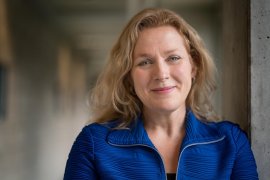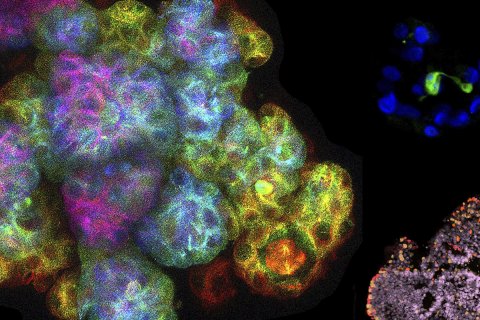The mathematical formula for our state of being reads rather simple: genes plus environment equals our health score. We’ve sequenced our genes to identify the genetic component of disease, but the environment remains the biggest unknown part of our health equation. Until now. This is the story of how researchers in Utrecht are starting to systematically sequence the environmental factors influencing our health – mapping out the outside world as well as the miniature worlds existing, for instance, in our intestinal tracts. Decoding life. One block at a time.
Decoding the exposome, the biggest influencer on health
Estimated reading time: 19 minutes
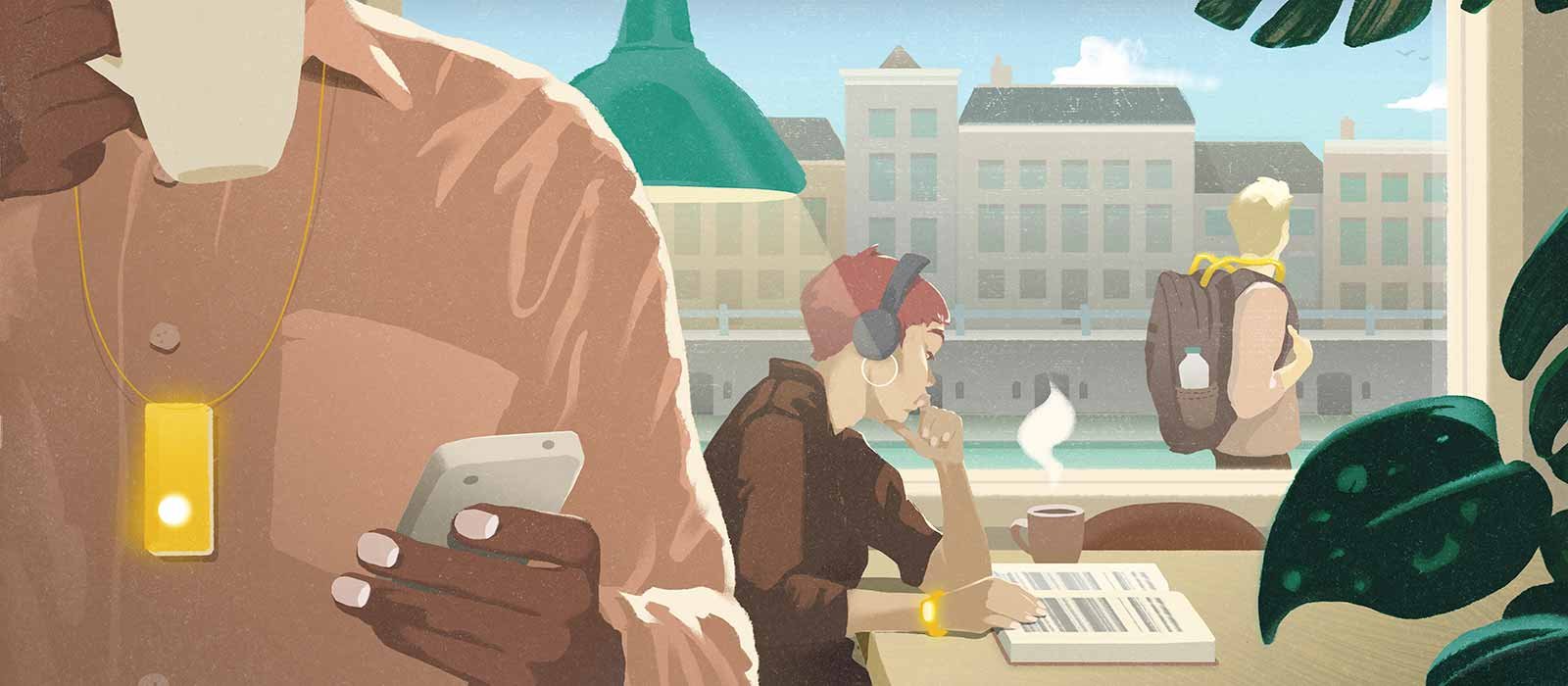
The blueprints of our surroundings…
A newborn today can easily reach the age of 85 with an enviable health or linger from sickness to sickness until the final mortal blow 40 years after.
We are living longer, no doubt, but are we living healthier? What is making us sick in the 21st century?
Over the past decades, we’ve managed to eradicate smallpox, combat malaria and fight off infectious disease epidemics that used to kill populations in the thousands, especially the most vulnerable and worst-off. Today, we’re more likely to fall apart slowly to heart and respiratory diseases, diabetes, cancer or neurodegenerative disorders. Ironically, we’ve succumbed to our own success, paying the price of economic development with obesity, depression and high blood pressure.
These “conditions”, in a perverse twist of fate, put us at an even higher risk when faced with a brand-new infection like the novel coronavirus. Yet unlike COVID-19, these aren’t on the news daily, but they are daily news: every year, 17 million people die of cardiovascular diseases, nearly 265 million around the world are estimated to live with depression and every sixth death in the world is due to cancer.
The further back in time one goes, the starker our differences become. Along the way from savannas to concrete jungles, we’ve also caught on hay fever and food allergies unknown to our ancestors. If we have been carrying similar DNA for thousands of years without being allergic, something else is going on that cannot be explained by genetics alone. The environment must play a role.
We sort of already knew that, you may contest. On Airs, Waters and Places, written in 400 B.C.E by Hippocrates, is evidence of the things from our surroundings “one ought to consider most attentively […] to investigate medicine properly.” So, how much and what exactly in our environment affects our health, your health?
A team of researchers from the Utrecht Exposome Hub, supported by the Netherlands Organisation for Scientific Research's Gravitation Programme, are happily taking on the ambitious task of mapping the numerous exposures and thousands of chemicals that surround us to finally understand what makes us sick, which environmental exposures are harmful and which are not, in which quantities and combinations, and if there are moments in life when we are particularly vulnerable.
Some are using sensors and wearables, from wristbands that soak up chemicals in a day’s life of a citizen to a fleet of cars that map out the quality of the air in dozens of cities simultaneously. Others are looking inside our bodies to identify how our metabolisms and immune systems greet pathogens and bacteria, but also external pollutants like lead or mercury and everyday chemicals that pervade vegetables, fragrances and digital devices.
They are spurring a new science. It is called exposome and it captures the sum of all environmental exposures over a lifetime.
Think of the number of invisible molecules one comes across from cradle to grave and the number of hidden forces that shape us. The bad ones quickly make headlines: toxic chemicals, toxic relationships, toxic culture... The pioneers of exposome research readily admit that we cannot control them all, but they are confident that if we better understand how these environmental factors impact our health, we can make the right lifestyle choices, from what foods are safe to eat to what city roads are best to avoid. On top of that, all this new data can support policymaking to rethink what we, as a society, need to change in our environment so that it invites healthier lives.
Enter the exposome.
The exposome is poised to provide a wealth of information on how our environment can influence health.
Genome & exposome: Nature times nurture
When the Human Genome Project started in 1990, scientists hoped to access the genetic library of the human body in order to better understand how our body works, what happens when it doesn’t work properly and ultimately combat some of the most prevalent human diseases.
And while, in just a decade, the Human Genome Project helped identify which genes predispose to certain maladies, enabling early intervention, insights into chronic diseases have encountered limitations. For one main reason: our genes never work in isolation. Instead, they interact with our dietary choices, social life and physical environment to either benefit or harm our health.
We can’t (easily) change our genes, but if we are serious about the prevention of diseases, we need to know the modifiable part – that is, the environmental factors.
If our genetics may dictate what is destined, those external influences determine what is possible in the spectrum of health and disease. Researchers from Utrecht University and UMC Utrecht are bringing attention to the extent of that influence.
“Environmental factors are responsible for as much as 70 to 80 percent of the risk to develop non-communicable diseases, such as heart disease,” says Roel Vermeulen, a Professor of Environmental Epidemiology and Exposome Science at Utrecht University and UMC Utrecht. He is the initiator of the Utrecht Exposome Hub, the prestigious Dutch-funded 10-year Gravitation Programme Exposome-NL, and currently leads the European Human Exposome Network.
The Utrecht Exposome Hub kicked off in March 2018 to complete the puzzle of how and why people get sick. There are currently more than 45 researchers involved, varying from toxicologists to epidemiologists, nutritionists, psychologists and urban planners, who all immediately agreed that if we are to understand how our environment influences our health, we will need to take a deep dive into the molecules around us and the fingerprints inside us.
Sign up for Massive Open Online Course (MOOC)
The exposome: cracking the science about what makes us sick
In this course, 7 researchers from Utrecht University and/or the NWO Gravitation programme Exposome-NL will introduce you to the Exposome concept; why it’s important; how they measure it; and the data sciences steps needed to establish associations with health outcomes. This course will conclude with reflections on what is needed to advance this nascent and transformative field of research.
The world of chemicals within us
That is an ambitious task. Consider this: the number of chemicals in our environment has increased from 20 million in 2002 to 156 million in 2019. The air you breathe, the food you eat, the water you drink, the medicines you take, the products you use or the surfaces you touch – they all contain a multitude of chemicals we were not even aware of.
Some occur naturally in our environment and many others are produced by the chemical industry. They have become ubiquitous in our living environment, desirably and ominously in equal parts, and often inadvertently. From perfluoroalkyl and polyfluoroalkyl substances (PFAS) in your teflon-coated cooking inventory to flame retardants that escape from your beloved phone or couch and collect in your household dust.
During your daily shower, you may come across no less than 20 different chemicals. If you shampoo your hair, an additional 30. Apply facial cream, deodorant, perfume, lipstick or aftershave, and your morning routine can add hundreds of chemicals to your skin before you even leave your home.
Overwhelming, eh? What is most shocking is that we do not really know the health effects of many of the chemicals in the market today. There is increasing evidence that many of the chemical substances from household products, packaging, food, medicines or cosmetics upset the hormonal balance in the body – they go by the name of ‘endocrine disrupting chemicals’ (EDCs). They could play a role in metabolic disorders such as obesity, diabetes and fatty liver disease.
It feels like the biggest uncontrolled experiment on people’s health is taking place right under our noses...
Those in the exposomics field at Utrecht University want to change this level of uncertainty about our living environment. To do so, “an investment and effort comparable to that of the Human Genome Project is required to map the ‘dark matter’ of the chemistry that surrounds us and the cloud of microorganisms that live within and amongst us all the time,” says Roel Vermeulen. The opposite, inaction, is giving us an “unbalanced view of human health,” Vermeulen stresses. With determination and also advanced tools, scientists in Utrecht are making a bold start to decipher this giant jigsaw puzzle.
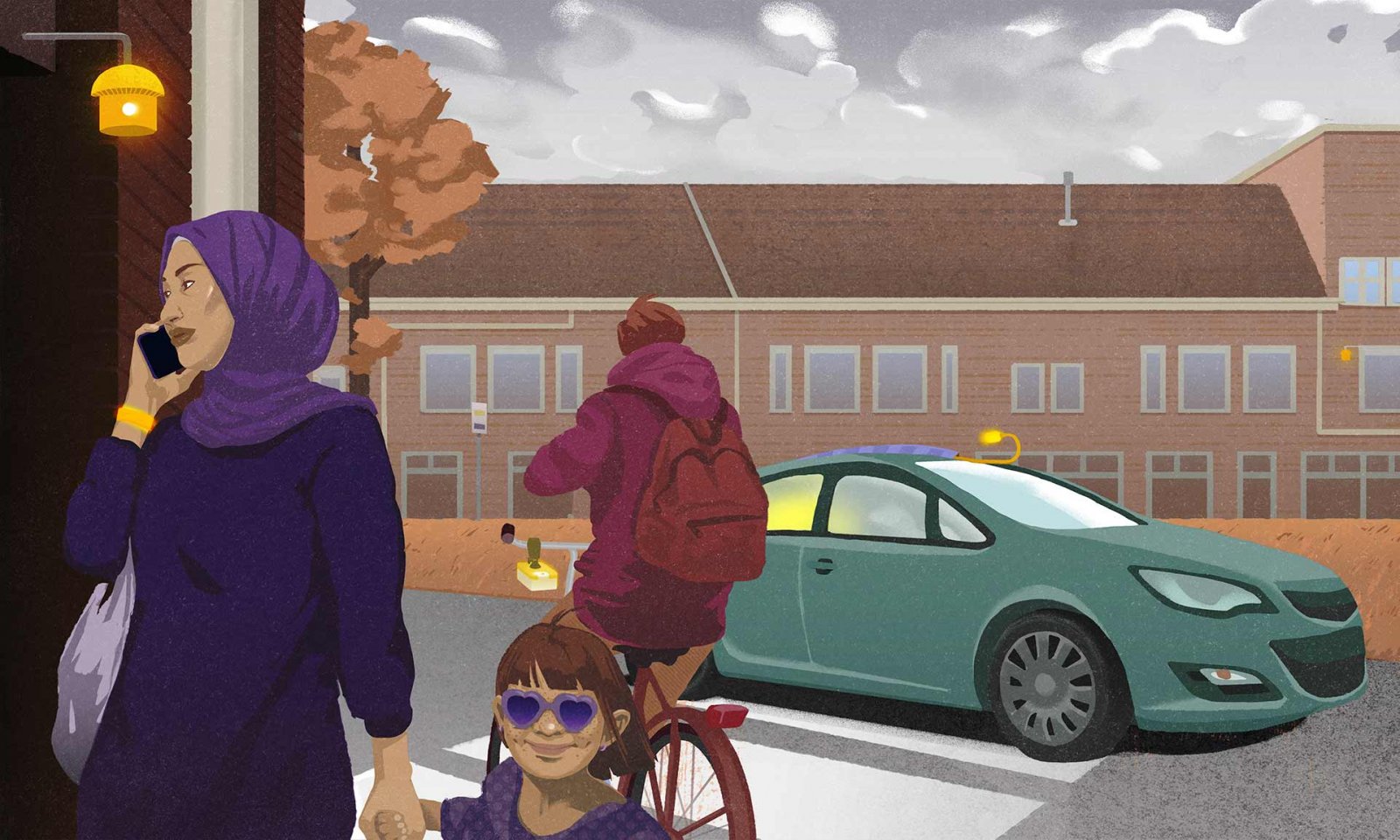
How to measure the invisible
The high number of chemicals around us is a priori alarming, but it is worth noting that some of these compounds either do very little or their concentrations in daily products are so low that they can stay comfortably within safety levels of exposure. But others, even if in low quantities, can interact with other molecules around us or the metabolites inside us and set off an adverse chain reaction. So how do we scrutinize these interactions?
Measuring someone’s ‘exposome’ is far more difficult than measuring their genome, as Vermeulen explains. “There is no one single method that can measure every factor, as is the case in genetic research. The exposome is also variable over time, in contrast to the genome. This requires a multi-disciplinary approach in which we use new technological developments from a variety of fields, such as sensors, spatial models and omics methods to study the function of the entire exposome in a cell, tissue or organ.”
Roel Vermeulen and his team advocate for a systematic approach rather than the traditional approach of investigating the relationship between one chemical and one disease. They are going big, for instance by involving 10,000 Europeans who suffer from chronic obstructive pulmonary disease (COPD), mapping their social, physical and chemical environments and deciphering the biological consequences by screening for all the 20,000 molecules (e.g. lipids, sugars, acids, amines, oxylipines) present in each blood sample. The goal? To identify which of those elements or which particular combinations can be linked to the disease.
“One of the most exciting parts of screening the exposome in this way is that it allows for a systematic evaluation of the relationship between environmental exposures and associated biological consequences, representing a powerful approach for the discovery in health and disease.”
Enter the whole world of microorganisms living within us.
Unlocking the secrets of the microbiome
Consider that our guts alone hosts 100 trillion microbes each! Marcel de Zoete, an Associate Professor of Host-Microbiota Interactions at the Department of Medical Microbiology and one of the principal investigators at the Utrecht Exposome Hub, has a deep interest in knowing them all – or at least, getting to know the more pathogenic members of this ecosystem now branded as the microbiota.
“There are hundreds of different bacterial species in the intestinal gut – it’s almost as if we’d have an extra organ that digests food, metabolises drugs, fine-tunes our immune systems, everything!”, he explains enthusiastically. “But not everybody has the same type of bacteria, so we are studying which bacterial species cause inflammations which may predispose someone to diseases such as colorectal cancer or inflammatory bowel disease.”
It is a very incipient field. Fernanda Paganelli, an Assistant Professor of Medical Microbiology and Marcel’s counterpart at the Utrecht Exposome Hub, explains that our ability to sequence all these bacteria has been made possible only 10 or 15 years ago. “Now we are trying to understand what these different bacteria do and, especially, how different combinations or communities of bacteria affect disease.”
The ability to sequence all the bacteria in our intestinal tract opened up a whole new world to understanding why certain people get sick, but not others. We are now investigating which specific bacteria or community of bacteria are responsible for immune diseases, cancer, diabetes or infection diseases.
This new understanding may have a huge impact on the treating of chronic conditions.
Take obesity, for example. To many in the public square of prejudice, people with obesity just eat too much junk food and exercise too little. Fernanda and other investigators from the Utrecht Exposome Hub wanted to examine the role of the microbiome on weight loss for patients with morbid obesity. They studied the changes of intestinal microbial communities in faecal samples from 45 patients who underwent a crash diet, followed by bariatric surgery (stomach reduction) at the Catharina Hospital in Eindhoven.
“Six months later, the composition of the intestinal microbiota in these patients had changed permanently. These long-lasting changes were already observed within just two weeks after surgery,” Fernanda explains. “This is probably a reflection of the adaptation of the microbiota to the anatomical and physiological changes that patients have undergone, and may represent one of the key factors why this surgical procedure results in substantial and durable weight loss.” The team is using these insights to find less invasive methods that can bypass the need for surgery and still achieve the same lasting metabolic changes responsible for weight loss.
Marcel chimes in: “It is clear that your stomach pre-digests your diet. So while diet certainly plays a role, that can be in combination with your own stomach and gut microbiota.”
When we have a clearer understanding of the ways in which the microbiome influences the host, we can take the next big step: manipulating the intestinal microbiota in order to benefit health.
When our inner and outer worlds meet
Perhaps the most fascinating thing about these inner and outer worlds is that they come together in Utrecht. As all researchers from the Exposome Hub Utrecht suggest, a person’s exposome is the result of all these separate but interacting ‘clouds’. A better understanding of how our different unique microbiomes mediate in these interactions can help explain why individual exposomes can be so strikingly different.
Epidemiologist Virissa Lenters, who works closely with Marcel de Zoete and Fernanda Paganelli in the Hub, studies exactly those interactions between the environmental cloud and the more personal one made up of hundreds of bacteria, fungi and protozoa. “I want to understand how the environment disrupts our gut microbiomes and how differently that goes between people.” She explains that a cycle of antibiotics, taking a plane or getting an infection can dramatically perturb the gut microbiome in a matter of days. “The amount of good and bad bacteria relative to each other can change very quickly. What is very difficult to change, however, is the type of bacteria present in your microbiome,” she specifies.
I want to understand how we can get a resilient microbiome that can help us better withstand the environmental insults that we are exposed to daily and protect us against pollution.
“I am studying which of the chemical pollutants we’re exposed to, for example in our drinking water, foods and household products, are the worst for our microbiome,” she explains. “That would be important for chemical legislation – if chemicals are found to be harmful, we can demand their removal from the market and focus on developing alternative, greener chemicals.”
Together, their approaches breathe new life into traditional (epidemiological) studies, which have previously focused on linking one single disease to one or more suspected environmental exposures. A history of lead poisoning among the ancient Romans led the architect Vitruvius (upon whose work Leonardo da Vinci based his Vitruvian Man) to discourage the use of lead water pipes in buildings. British doctor John Snow demonstrated the link between contaminated water and the onset of a cholera epidemic in the district Soho, London, that killed over 600 people in the mid-nineteenth century after correlating residents’ access to the Broad Street water pump and the map of deaths.
Early exposure, a lifetime of consequences
The developing baby in the mother’s womb is especially vulnerable to the exposure to environmental pollutants, and the effects of such early life exposure have been linked to increased incidence of cancer, diabetes and obesity, as well as other developmental, reproductive and neurological effects that can manifest long after birth.
Unmasking compounds with adverse health impacts is all the more urgent as a variety of environmental pollutants have been detected in umbilical-cord blood, placentas, amniotic fluid and meconium.
Utrecht University PhD candidate Hanna Dusza and Professor of Toxicology Juliette Legler developed a robust methodology to characterize fetal exposure to a wide spectrum of endocrine disrupting chemicals (EDCs) in amniotic fluid. This method can be used to identify unknown EDCs and is an important step to further study how exposure to these compounds in a mother’s womb may affect children’s health.
The developing baby is exposed to more compounds with potential endocrine-disrupting activities than we ever knew before. It is essential to identify these unknown EDCs in order to determine their risk to a baby’s health and to take steps to reduce exposures.
Imagine you could be able to see what is usually invisible to the naked eye. Bacteria, viruses, chemicals, fungi and even tiny microscopic particles that enter your personal space. What would your exposure look like? How much would it differ from your neighbour or from a relative living far away?
Roel Vermeulen and his team wanted to visualize invisible air pollution, starting with measuring the exposome, one layer at a time.
What’s in the air?
Air pollution is a silent killer. Between 4 to 9 million people are estimated to die prematurely each year as a consequence of dirty air, meaning air pollution now kills as many people as smoking tobacco. An accurate figure of how many lives are lost or dented is tricky because dirty air is more of a disease-risk multiplier rather than a single cause, typically worsening the effects of other respiratory diseases such as asthma, pneumonia or cystic fibrosis.
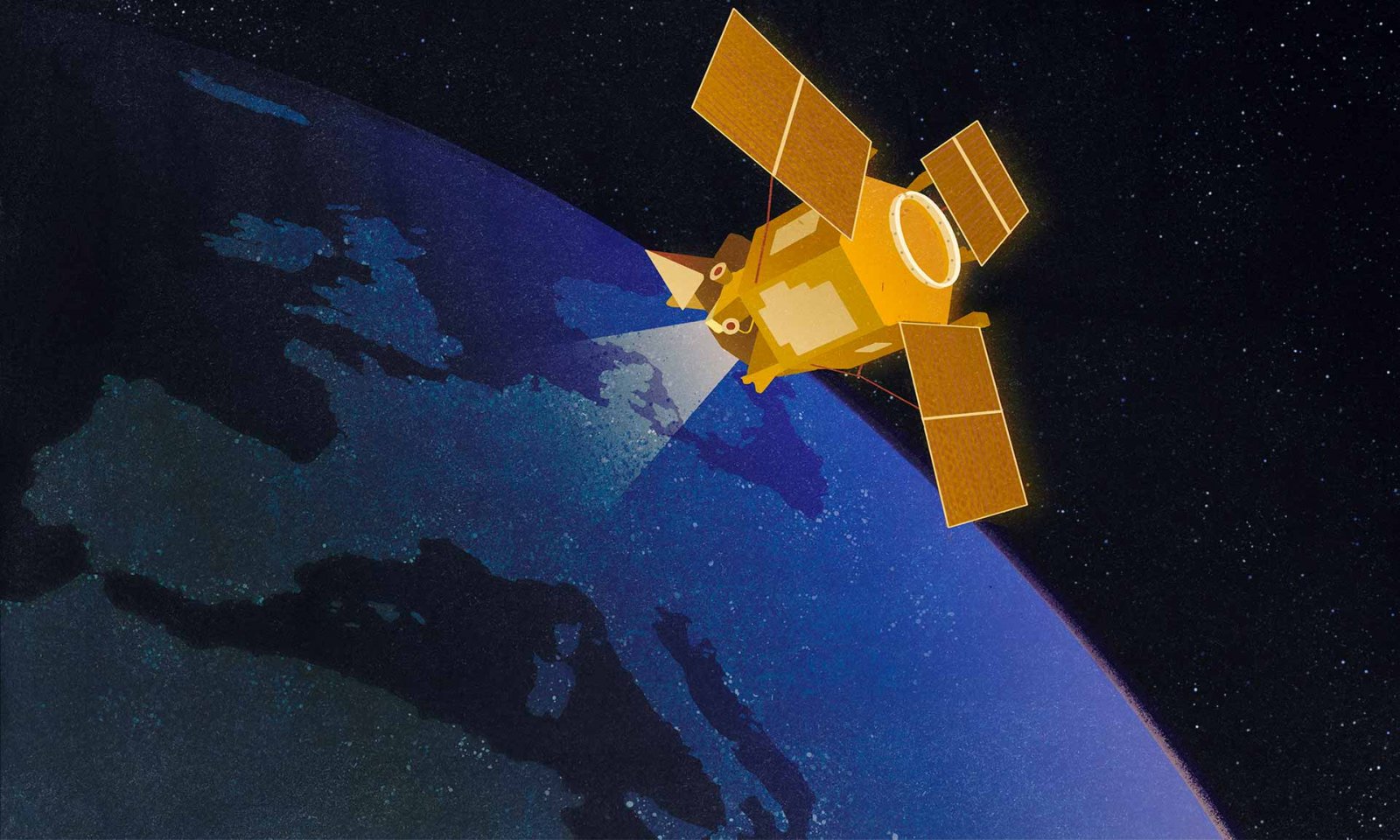
Cities typically map out air quality with a limited number of measuring stations, but air quality (and pollution) can change block by block, day to day. Many measurements only account for a few regulatory agents. That’s a fragmented picture.
Ultrafine particulate matter, particles of nanoscale size (less than 0.1 microns in diameter) from the exhaust of cars, aren’t among those routinely measured. However, they can penetrate deep into the lungs and bloodstream, and increase the risk of respiratory and cardiovascular diseases.
Roel Vermeulen and his team wanted to take a high-resolution picture of air pollution, so they started by placing measuring equipment in electric cars in Utrecht. But more data was needed, which is why they looked for a way to gather global data. Vermeulen was part of the team who started a unique collaboration with big tech company Google. The ‘street view cars’ that the tech giant uses were fitted with sensor technology to measure air quality. The team started these rides in Oakland, and later expanded to Amsterdam and Copenhagen. In addition to the usual snapshots that configure Google Street Maps to take you from A to B, those car rides were testing for nitrogen oxides, fine dust, soot and ultra-fine dust, and providing researchers with air-quality data at street level. The result: a “map of hyperlocal air quality” that can tell residents which route to cycle to work on in order to circumvent the rush hour of car exhaust.
We are happy to partner with industries that make our ideas scalable - this collaboration with Google enables us to map air pollution in an entire city in an unprecedented resolution.
Big data for healthier policies
This map is also much more insightful than a personalized health advice. It is a first layer of information successfully decoded from our physical environment that could then be built on top of land-use maps and matched against health records of patients with chronic diseases.
And voila! Suddenly it becomes clear how and to what extent reducing air pollution, by for example adding new green spaces in cities, improves the health of residents.
The insights are far-reaching for policy too. As Gerard Hoek, an Associate Professor of Environmental Epidemiology who is researching the cumulative effects of airborne molecules on our health notes: “We had underestimated the impact of ultra-fine particulate matter in the respiratory health of the population in the Netherlands and further afield. The EU still has a limit value for fine particulate matter that is two and half times higher than the current WHO air quality guidelines. This type of evidence can tip the balance for better regulation.”
We are exposed to multiple exposures at once. Together, they are likely to have much stronger health effects than any single exposure alone, so this multi-exposure approach can give ammunition to move toward more integrated policy solutions.
All this information about air quality can help planners to locate and tackle areas with poor air quality. Copenhagen is already using the maps to work with architects and designers to rethink the future for a healthy and thriving city.
In order to facilitate the usability of the obtained data and increase the uptake of knowledge, Utrecht University, the Netherlands Institute for Public Health and the Environment and the Economic Board Utrecht have launched the Data and Knowledge Hub Healthy Urban Living. In this ecosystem, more than 10 partners from the public and private sectors are working together towards the common goal of healthy environments for all.
Detoxing our future, layer by layer
Technology to map the exposome is maturing rapidly. If there is a substantial collaborative effort, this could be the single major step towards uncovering the mysteries of human biology. Some immediately see the potential of exposome knowledge to provide individual health advice and healthcare.
For researchers at Utrecht University, the most important results from these findings are far beyond individualised, personalized medicine. The ultimate benefits are social and, possibly, global – a better understanding of the exposome will lead to the improvement of disease prevention and influence policies that can promote healthy habits and environments, or prevent harmful risk factors in the first place.
As Roel Vermeulen concludes: “That is important, because health inequalities in the world are large. In Utrecht, people who live in the best neighbourhoods live twelve years longer in good health than people in poorer neighbourhoods on average.”
We want to produce an exposome map that will enable policymakers to see where there are hotspots with few or many risk factors for diseases.
The future for exposome researchers in Utrecht starts by producing a layered map of the exposome that can enable policymakers to see where there are hotspots for diseases, catering for factors such as air quality, green areas, food environments or the possibilities for physical exercise. This is all the more important, as global warming and its expected ecological shifts will only worsen the environment we live in.
This makes the work of the Utrecht Exposome Hub a first, yet important, step to identify and curb the far-reaching consequences of any substance we put out in our environment. Pre-polluting our children is a high price to pay. The leitmotif of this science is that prevention is better than cure.













